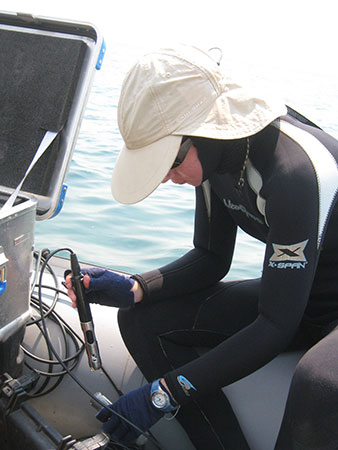Fish Diversity and Nutrient Recycling
(Since this post was written and this study was conducted, the environmental foundation Global Nature Fund (GNF) nominated Lake Tanganyika as the Threatened Lake of the Year 2017. The GNF also called for sustainable measures to preserve the lake, which accounts for 17 percent of the world's freshwater and is the source of life for millions of people.)
Lake Tanganyika in East Africa is the second deepest lake in the world reaching a maximum depth of 1,470 m (4,820 feet) and is also the second-largest lake by volume. The lake is divided among the countries of Burundi, Democratic Republic of the Congo (DRC), Tanzania, and Zambia. Most of the lake’s massive volume of water sits in its dark depths, where a lack of oxygen makes it impossible for fish and other animals to live. But swimming near the well-lit shoreline is one of the most diverse freshwater fish communities in the world. The lake supports nearly 275 fish species, many of which are endemic and are popular aquarium pets. In fact, nearly 98% of the Tanganyika cichlid species are found nowhere else.
The littoral (nearshore) ecosystem of Lake Tanganyika is the freshwater analog of a coral reef. The clear, shallow waters at the lake’s edge are low in nutrients, but the attached algae (periphyton or microphytobenthos) are highly productive and support the diverse fish community.
Dr. Yvonne Vadeboncoeur (Department of Biological Sciences, Wright State University) and Dr. Peter McIntyre (Center for Limnology, University of Wisconsin) are studying the relationships between fish abundance, periphyton productivity, and nutrient upwelling in Lake Tanganyika. They are exploring the key roles that grazing and nutrient excretion by fish play in maintaining high ecosystem production.
For years, lake ecologists have assumed that phytoplankton, or algae in the water column, are the main source of primary production in lakes. However, evidence is accumulating that in lakes of all sizes, periphyton forms the energetic base of littoral food webs.
Furthermore, the vast majority of fish species in lakes feed in the littoral zone. In doing so, the fish rely on periphyton for energy, either through direct consumption or by consuming invertebrates that graze on periphyton. In Lake Tanganyika and other African Rift Valley lakes, the majority of the fish species are grazers and consume periphyton directly. Therefore, periphyton productivity is critical to understanding littoral ecosystem dynamics. But quantification of the role of periphyton in lake ecosystem functioning has been hampered by logistical constraints associated with measuring periphyton productivity.
Chamber methods for measuring phytoplankton productivity are well-established and usually include the use of 14ºC to measure carbon uptake. In contrast, benthic primary productivity is not a routine measurement in lakes. Initial methods also used 14ºC, but it became increasingly obvious that benthic biofilms have high productivity rates. The high photosynthesis rates made bulk oxygen exchange methods a viable alternative to tracer methods.
Periphyton on rocks or intact sediment cores are easily isolated in chambers. Large changes in oxygen in light and dark chambers can be detected over short incubation periods (15 minutes to 2 hours). The tricky part is getting an accurate oxygen measurement while, at the same time, preventing exchange with the atmosphere. Agitation of the sample introduces error.
Stirring is not required to make accurate measurements of oxygen with the YSI ProODO (now the YSI ProSolo), and the ProSolo has increased both the speed and repeatability of the benthic primary productivity measurements. Intact periphyton communities are incubated in chambers, either in situ or under lights in the lab. Immediately before withdrawing a water sample, the water is stirred in the chamber with a built-in rotatable paddle, or the entire chamber is rotated to mix the water. No air is in the chamber, so this procedure breaks down any oxygen gradients in the chamber without introducing air that would affect the readings.
Water samples are then withdrawn using a disposable, needle-less, 60 cc syringe. The entire syringe is filled with water, and extreme care is used to prevent the introduction of any air into the syringe. After the syringe is filled, a small rubber cap is placed on its terminus. After the diver returns to the surface, the internal plunger of the syringe is carefully removed, and replaced with the ProSolo optical-based dissolved oxygen sensor.
The stainless steel probe guard that protects the optical sensor fits perfectly inside the syringe, and it holds the sensor in the center of the water sample. In less than 40 seconds, researchers have an accurate oxygen measurement. This technique is very fast and allows for many more measurements than previous methods. The ability to make a high number of replicate measurements addresses the common concern of high spatial heterogeneity in periphyton biofilms.
By measuring benthic primary productivity and nutrient uptake in Lake Tanganyika, researchers are beginning to understand how this ecosystem supports so many fish. The fish persistently graze the periphyton, and the water itself is extremely nutrient-poor. The biomass of the periphyton is incredibly low, but data from the measurements demonstrate that the algae on the rocks are incredibly productive.
How do such high productivity and diversity persist in the face of apparent extreme nutrient scarcity? It is believed the answer lies in the grazing fish themselves. Most of the nutrients in the system are actually in the bodies of the fish. By staying in the surface waters and feeding on algae, the fish keep the nutrients in the lighted waters where the algae can use them. The fish continually excrete small amounts of nutrients as waste products, and this helps maintain high algal productivity. Ongoing lab and field experiments are helping us to understand the mechanisms underlying the high ecosystem production and high fish diversity in Lake Tanganyika.
Additional Blog Posts of Interest:
What is Affecting Your Dissolved Oxygen Measurements? Part 1 of 4
Dissolved Oxygen Meters - Which Membrane Type Should I Use?
What is Affecting Your Dissolved Oxygen Measurements? Part 2 of 4
Aquaculture Raceway Shrimp Production with Dissolved Oxygen Monitoring